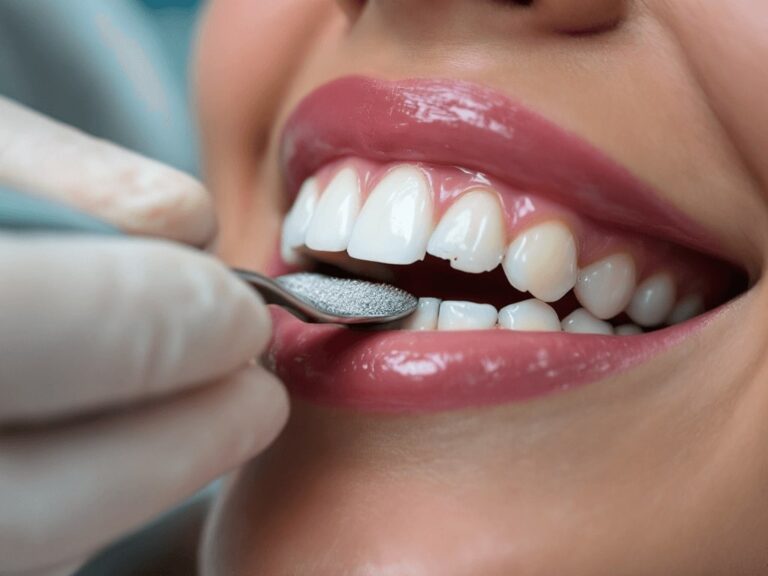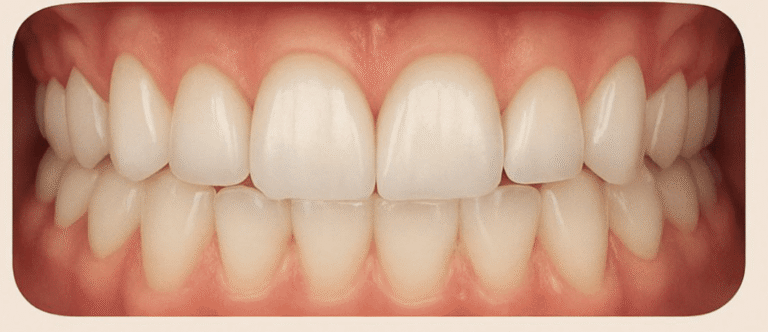Originally published on April 9th, 2024. Updated on June 1st, 2025.
Cosmetic Dentistry vs Real-Life Results: Your Porcelain Veneer Guide!
Should I get porcelain veneers? In this comprehensive guide, we’re delving deep into the world of porcelain veneers to provide you with honest answers to the most common questions.
Here you wont find the usual glossed-over responses, here, you’ll find nothing but the unfiltered truth, empowering you to make informed decisions about your dental health journey!
Here, we’ll provide the standard response commonly found across the internet and often promoted to patients, followed by genuine insights from our BeautyBeyondVeneer Team, drawing from over 20 years of experience.

1. How do porcelain veneers work/ how dental veneers work & how are porcelain veneers applied?
Textbook Answer: A porcelain veneer is a wafer-thin layer of porcelain bonded to the front surface of a tooth to enhance its appearance, color, and shape.
Porcelain veneers are applied in a multi-step process. First, a thin layer of enamel is removed from the tooth’s surface, then the custom-made veneer is bonded to the front of the tooth using dental cement.
BeautyBeyondVeneers Team:
Contrary to popular belief, porcelain veneers aren’t merely bonded to the front surface of a tooth like a sticker.
In reality, the porcelain wraps under and behind the tooth, altering its structure significantly.

The degree to which the porcelain extends behind the tooth’s surface is a matter of debate, but it’s believed to be at least 20%, with the possibility of being more depending on the type of porcelain used.
This can affect speech, chewing function, and create a sense of foreignness in the mouth as the bottom of the veneers interact with the lower teeth during these activities.
Additionally, the term “wafer-thin” is misleading as the degree of enamel removal varies, often resulting in substantial tooth alteration.
Composite veneers, however, do not exhibit this phenomenon. To learn more about this check out our article, “Mastering the Art of Aesthetics: Composite vs Porcelain Veneers: The Case for Composite Veneers”
How is enamel removed from porcelain veneers?
Dentists typically use a dental drill or a rotary instrument equipped with a diamond burr to remove enamel when preparing teeth for porcelain veneers. Ouch!
Thus, the conventional depiction of porcelain veneers oversimplifies the process and fails to highlight the irreversible damage they can cause to natural teeth.
What about no prep veneers?
The idea of “no-prep” veneers is unrealistic as they typically appear bulky & long affecting speech and chewing function. While some attempt it, the outcomes are often unsatisfactory, and upon removal, the bonded cement can still harm the natural tooth.
Restoring your teeth completely back to their original state, 100% before the “no prep” procedure is hardly reversible, to say the least.
For those intrigued by the scientific aspect, hydrofluoric acid or phosphoric acid is frequently utilized in bonding porcelain veneers to teeth, assisting in the process of etching the tooth surface to improve adhesion.
Both acids are corrosive and can present dangers if it comes into contact with the skin, nasal passages, throat, or eyes. You do the math, Is this reversible?
So do porcelain veneers require shaving teeth? In nearly all cases, the answer is yes!
2. How Much Does Porcelain Veneers Cost?

Textbook Answer: The cost of porcelain veneers can vary depending on factors such as location, the dentist’s expertise, and the number of teeth being treated. How much porcelain veneers cost per tooth can be anywhere from $800 to $2,500 USA dollars.
BeautyBeyondVeneers Team:
Probably the most frequently asked question is how much dental veneers cost, which are often used interchangeably with porcelain veneers. Dental veneers typically range from $1000 to $3000 per tooth in the United States.
However, contrary to expectations, there is no money-back guarantee. In addition, unlike composite veneers, which can be easily and inexpensively repaired if chipped, porcelain veneers cannot be fixed, posing a risk to the patient.
Paying a higher price, like $3000 per tooth, doesn’t necessarily guarantee superior quality compared to a lower cost, such as $1000. To truly assess the quality of the veneers, it’s essential to meet with the ceramist responsible for crafting them at the porcelain veneers lab.
However, cosmetic dentists typically refrain from introducing patients to ceramists, as it goes against industry protocol and remains a hidden secret in the field. This arrangement leaves patients unable to communicate directly with the individuals fabricating the veneers, which is another undisclosed flaw.
Essentially, the dentist acts as a middleman, performing the service but not manufacturing the product, creating a perplexing situation for patients who may not be aware of this arrangement.
This significant issue often leads to unsatisfactory veneer results because patients place full trust in the cosmetic dentist, who ultimately has limited control over the porcelain veneer quality.
As previously stated, this procedure might jeopardize the structural integrity of the underlying teeth, leaving you with limited options if you are unhappy with them.
Should I get porcelain veneers? Are porcelain veneers worth it?
So are porcelain veneers expensive?
Returning to the topic of expenses, a complete smile in the USA makeover encompassing 10 teeth on both upper and lower teeth could tally up to $60k with no money-back guarantee.
How much are porcelain veneers in Mexico?
Porcelain veneers’ prices in Mexico and elsewhere may fluctuate, often being more budget-friendly, typically around $450 to $600 per tooth. Thorough research is crucial, as certain dentists outside the USA are recognized for delivering top-notch results, contrary to what some US dentists may suggest.
How much are porcelain veneers in Colombia?
Porcelain veneers in Colombia typically range from $500 to $700 per tooth, although prices can fluctuate. Despite being cheaper than in the USA, potential follow-up concerns may arise, especially if travel to Colombia is required. Mexico and Colombia are among the top destinations for US travelers seeking dental care, alongside Dubai.
3. Do porcelain veneers last forever, how long do they last, and are porcelain veneers permanent?

Textbook Answer: Porcelain veneers are not permanent and do not last forever. On average, they can last between 10 to 15 years, but this can vary depending on factors like oral hygiene, habits, and the quality of the veneers.
While they offer a long-lasting solution for smile enhancement, they may eventually require replacement due to wear or damage over time.
BeautyBeyondVeneers Team:
Porcelain veneers can indeed last for a considerable period, lasting anywhere from their initial application to as long as 20 years, contingent upon factors like oral hygiene and lifestyle choices.
While they are not permanent fixtures like natural teeth, they are considered permanent in the sense that they require replacement once they chip, crack, or reach the end of their lifespan.
It’s essential to note that the process of applying porcelain veneers involves removing a thin layer of enamel from the teeth, which is irreversible and permanently alters the tooth structure.
Although there are rare occurrences of transitioning from porcelain to composite veneers, such procedures are not commonplace, and locating a dentist in the USA willing to perform them is exceedingly difficult.
Our BeautyBeyondVeneers team has connections with specialists who may undertake such cases, a topic we will delve into in future posts.
Quickfire Round: BeautyBeyondVeneers Gives Straight Answers!

4. Do Porcelain Veneers Break Easily?
Porcelain veneers are susceptible to breakage, especially under significant force or impact, but their durability varies based on material quality and oral habits.
It’s crucial to consider individual needs when assessing the suitability of veneers, as factors like teeth grinding, sports participation without mouthguards, or previous dental trauma increase the risk of breakage.
Additionally, individuals with misaligned bites or those who exert excessive force during biting or chewing are more prone to experiencing porcelain veneer damage.
5. Do Porcelain Veneers Stain?
Don’t be fooled. Porcelain veneers are often advertised as stain proof because porcelain is nonporous, but the truth is they can and do stain, especially once the protective glaze wears off. Without that glaze, the surface becomes vulnerable to discoloration from everyday foods and drink
Contributing factors to staining include:
- Loss of glaze – The glossy coating that helps resist stains can wear off over time, especially from chewing or grinding.
- Surface scratches – Abrasive toothpaste or hard brushing can create micro-scratches that trap pigments.
- Plaque and tartar buildup – Poor oral hygiene can lead to buildup that affects the veneer’s appearance.
- Gum recession – As gums recede, edges of the veneers or bonding material can become exposed and more likely to discolor.
- Smoking or vaping – Tobacco products can accelerate staining and degrade the glaze faster.
- Frequent exposure to staining agents – Regular consumption of coffee, tea, wine, berries, or curry increases the risk, especially if veneers are already worn.
6. Can Porcelain Veneers be Whitened?
Porcelain veneers can NOT be whitened due to their non-porous nature, which prevents substances from penetrating their surface.

While some individuals may attempt to whiten the natural teeth behind the veneers, the efficacy of this method is uncertain, as the results vary and are still debated within the dental community.
Don’t waste your money on porcelain veneer whitening toothpaste; it’s a scam.
7. Do Porcelain Protect Your Teeth?
Oh, sure, porcelain veneers protect your teeth! But first, let’s destroy your enamel to get them to stick. So, technically, they’re not protecting your teeth; they’re just taking over after wreaking havoc.
Disclaimer: If your teeth are irreparably damaged by decay or erosion, porcelain veneers might offer some protection for the remaining tooth structure. However, in such cases, a dental cap or crown may be a more suitable option.
8. Can Porcelain veneers be replaced?
Porcelain veneers can indeed be replaced, but each replacement requires the installation of new porcelain and the removal of additional tooth structure to ensure proper bonding.
This process is often overlooked by dentists and patients alike, leading to potential complications over time.
With repeated replacements, the underlying tooth structure may become compromised, ultimately necessitating more invasive procedures such as dentures or implants.
9. Do Porcelain Veneers hurt?
Yes!, but consulting a cosmetic dentist may not provide the most unbiased opinion. Dentists themselves would hardly opt for a full set of veneers, with less than 5% undergoing such a procedure.
Just picture enduring hours of teeth grinding with a rotary tool – it’s more like experiencing a harrowing ordeal than enjoying a leisurely stroll in the park.
10. Are Porcelain Veneers covered by insurance?
Insurance coverage for porcelain veneers is infrequent when it comes to cosmetic purposes, as they’re typically viewed as elective treatments by most insurance providers.
In rare instances where a porcelain veneer is deemed necessary for a non-cosmetic procedure, only a portion of the cost may be covered, leaving the patient responsible for the remainder.
It’s essential to clarify coverage details with your insurance provider beforehand, but don’t hold your breath for full coverage—it’s a rarity.
BONUS*
How Long Does it Take to Get Porcelain Veneers?
Getting porcelain veneers involves various phases, starting with initial consultations, mold-taking, and permanent enamel removal, followed by sending the veneers to a lab and fitting them upon their return.
This process typically lasts 1-3 weeks but may extend to months if adjustments are needed and veneers are sent back and forth to the lab. It’s worth noting that dentists don’t fabricate the porcelain veneers themselves.
Upon receiving the final porcelain veneers from the lab, patients frequently experience excitement fueled by marketing and the widespread portrayal of porcelain veneers’ success stories on TV, as well as before-and-after photos taken at flattering angles.
However, the reality is that many patients experience challenges with chewing and speaking after the procedure, especially once they return home.
Dentists often respond with “You’ll get used to it,” but they typically don’t provide support for speech therapy or assistance in adjusting to this significant change.
Patients typically have only about 15-30 minutes in the office to trial the new porcelain veneers before the permanent cementing process begins. Unfortunately, there’s no opportunity for trial adjustments at home for the new permanent porcelain laminates.
It’s important to note that the temporary veneers provided for trial after the enamel is ground off during the second visit are significantly different from the final porcelain veneers received when they come back from the lab.
This may contradict what you’ve been told, but it’s the reality. Temporary veneers are often shorter, less bulky, and closer in shape and size to your natural teeth compared to the final porcelain veneers.
This revelation may catch some off guard. Although the final laminates offer a superior aesthetic, discrepancies in size, shape, and thickness frequently emerge, resulting in challenges that dentists may overlook because they are not involved in the manufacturing process in-office.
Therefore, it’s essential to carefully consider whether the aesthetic benefits outweigh the time investment before opting for porcelain veneers.

Disclaimer: This content is for informational purposes only and does not constitute medical or dental advice. Always consult with a licensed dental professional before making decisions about your oral health.





